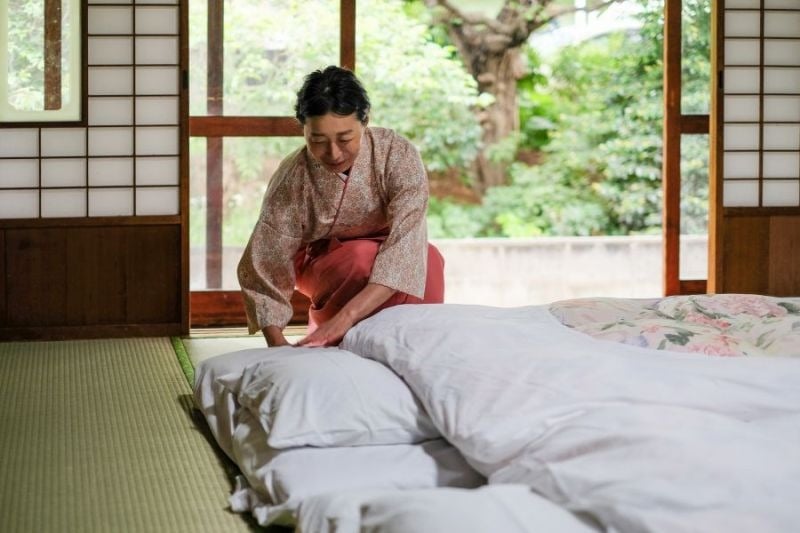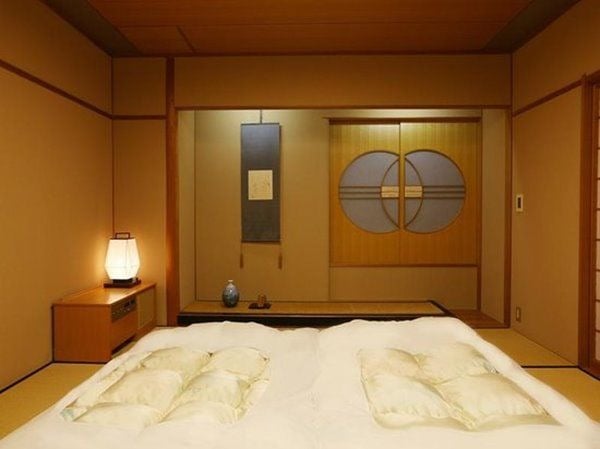We all love a good night’s sleep in a cozy bed, but the Japanese have a different preference. Even in luxurious and spacious homes, they opt for sleeping on the floor. So, what’s the reason behind this choice?
Making the Most of Living Spaces
In Japan, most families use tatami mats, a versatile piece of furniture. Tatami mats are not just ordinary mats but can double as a seating area when hosting guests or transformed into a comfortable sleeping space.
Additionally, due to Japan’s high population density and limited land, sleeping on tatami mats conserves space and optimizes living areas. Most homes are equipped with heating systems, ensuring a cozy atmosphere even during winter.

Tatami mats are a common feature in Japanese households.
Child Safety
The Japanese believe that sleeping on the floor is safer for young children. With traditional beds, there’s a risk of children rolling off if parents aren’t attentive. Sleeping on the floor eliminates this concern, allowing children to move around freely without the danger of falling.
Fear of Natural Disasters
Japan is prone to earthquakes, and its citizens are always prepared for such events. Early detection and quick response to earthquakes are crucial. Sleeping on the floor allows Japanese people to sense the vibrations more readily and seek safety.
If they slept on beds, they might not feel the tremors in time. Moreover, having fewer furnishings makes it easier to move swiftly during an earthquake.
Health Benefits
Many Japanese believe that sleeping on a very soft bed can be detrimental to bone health. They advocate for a mattress with moderate firmness, neither too hard nor too soft. In their view, sleeping on a flat, hard surface benefits the back and improves blood circulation as body weight is distributed evenly, reducing pressure on various body parts.
While soft beds provide comfort, over time, the mattress may sag, leading to spinal curvature and back pain. Additionally, sleeping on the floor reduces the risk of falls for the elderly when getting up from the sleeping surface.

Japanese people believe that very soft beds can be harmful to bone health.
The Japanese don’t just sleep on wooden floors; they also use tatami mats or thin mattresses. Tatami mats are made of tightly woven straw, providing a firm yet comfortable surface. Additionally, Japanese pillows are smaller and filled with beads. While they may feel firmer and less plush than traditional feather or fiber-filled pillows, they offer superior support for the neck and head.
Easier to Get Up in the Morning
Another reason why the Japanese prefer sleeping on the floor is that it makes it easier to get up in the morning. Often, the difficulty in rising early is attributed to the comfort of a soft bed, which can lead to sleeping in uncomfortable positions.
Sleeping on the floor provides a more restful sleep and reduces dependence on pillows and blankets in the morning.
Cultural Tradition
One of the primary reasons why the Japanese don’t sleep on beds is rooted in their cultural tradition. The practice of sleeping on the floor has been a part of Japanese culture for thousands of years and has been passed down through generations.
Soak Onions in Water: Amazing Benefits for Both Men and Women
The humble onion is a powerhouse of nutrients and a natural remedy for various ailments. Soaking onions in water unlocks their hidden powers, offering a simple and cost-effective way to boost your health. This age-old practice has been passed down through generations, and those in the know swear by its incredible benefits.




































